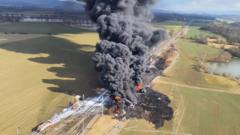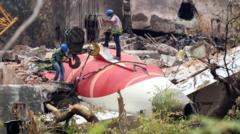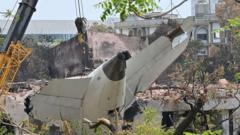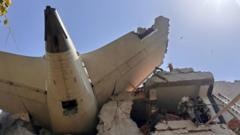A freight train derailment in the Czech Republic involving toxic benzene has led to a massive fire, with emergency services deployed to control the flames and monitor air quality.
Czech Emergency Services Combat Hazardous Train Fire

Czech Emergency Services Combat Hazardous Train Fire
Dramatic response to toxic benzene train derailment in the Czech Republic as firefighters battle raging inferno.
The Czech Republic faced a dramatic incident on Friday when a freight train carrying the highly toxic chemical benzene derailed near Hustopeče nad Bečvou, approximately 50 kilometers south-west of the Polish border. This derailment led to a significant fire that engulfed several tankers and the locomotive, creating a large, acrid cloud of black smoke visible for miles around. Fortunately, no injuries were reported.
According to initial reports, the train "split apart" before derailing, resulting in flames reaching heights of up to 20 meters. A nearby electric substation also caught fire as a result, disrupting power in the vicinity. Local eyewitnesses described the scene as catastrophic, stating that flames and thick black smoke filled the sky.
To combat the blaze, firefighters from multiple regions arrived, along with a mobile chemical laboratory equipped to handle hazardous materials. Dramatic drone footage released by the Czech fire service showcased the extent of the destruction, highlighting the charred remains of tankers still ablaze. Firefighters utilized heavy foam to contain the fire’s spread and hosed down unaffected tankers to prevent potential explosions. A helicopter was also involved in the response, which took several hours to bring under control.
Fire department spokesperson Lucie Balážová estimated that around 15 of the 17 benzene tanks on the train were affected. Each tanker contained roughly 60 tonnes of benzene, a flammable liquid with serious health risks associated with exposure. Local residents were advised to remain indoors, keeping windows and doors closed to avoid inhaling any harmful fumes, although authorities stated that air quality had not exceeded pollution thresholds.
As a precautionary measure, local police have announced an investigation into the cause of the derailment. Benzene, a colorless and highly volatile liquid, is commonly found in numerous industrial products, posing serious health risks through ingestion or inhalation, including drowsiness, dizziness, and the possibility of long-term complications.
According to initial reports, the train "split apart" before derailing, resulting in flames reaching heights of up to 20 meters. A nearby electric substation also caught fire as a result, disrupting power in the vicinity. Local eyewitnesses described the scene as catastrophic, stating that flames and thick black smoke filled the sky.
To combat the blaze, firefighters from multiple regions arrived, along with a mobile chemical laboratory equipped to handle hazardous materials. Dramatic drone footage released by the Czech fire service showcased the extent of the destruction, highlighting the charred remains of tankers still ablaze. Firefighters utilized heavy foam to contain the fire’s spread and hosed down unaffected tankers to prevent potential explosions. A helicopter was also involved in the response, which took several hours to bring under control.
Fire department spokesperson Lucie Balážová estimated that around 15 of the 17 benzene tanks on the train were affected. Each tanker contained roughly 60 tonnes of benzene, a flammable liquid with serious health risks associated with exposure. Local residents were advised to remain indoors, keeping windows and doors closed to avoid inhaling any harmful fumes, although authorities stated that air quality had not exceeded pollution thresholds.
As a precautionary measure, local police have announced an investigation into the cause of the derailment. Benzene, a colorless and highly volatile liquid, is commonly found in numerous industrial products, posing serious health risks through ingestion or inhalation, including drowsiness, dizziness, and the possibility of long-term complications.


















